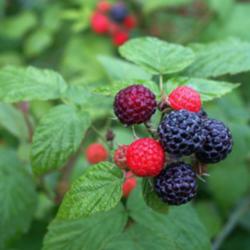| I would like to know the best time of the year to transplant black raspberries. There is an entire field of the in the sand pit across from my house, also what type of fertilizer should be used. |

You can move them this fall, too, though I believe spring planted canes will have a higher survival rate. Choose the ones with the healthiest looking primocanes (the canes that grew this year and will fruit next year), and water them thoroughly. Then prune the fruiting canes off (they die after they fruit anyway). Dig crowns so that you move a healthy amount of soil and root with them (6-8" radius from the crown on all sides). All new nursery planting requires consistent soil moisture in order to get well established, and also during their flowering and fruiting stage. Drip or leaky pipe irrigation is best, and mulch is recommended, too. Mulch also keeps down competing plants. It does sound like the wild canes are doing just fine on their own, though! You be the judge of how to care for them based on their performance after you transplant them. Now for pruning! All bramble fruit produces canes (primocanes) that spend the first season beefing up and storing food for its grand finale in its second year (when they're called floricanes). Whereas red/yellow raspberries grow sturdy, unbranched primocanes, black raspberries sprout long, branching, supple primocanes that tend to head back to earth. As you probably have witnessed, they take root at the tip, and this is actually how new plants are propogated! Black raspberries fruit on side branches, so you need to prune off the tops of the canes the year they appear to encourage branching. Ideally, in the first season, when the primocanes reach 18-24" tall, you should cut off the top 3-4". Late the next winter, before they start to grow, trim back the side branches to 8-12", which will stimulate even more fruiting side-branches! In the fall,after leaves have dropped from the canes, remove the floricanes by cutting them off at ground level (be careful not to scrape or jab the crown of the plant in the process, or you may damage next year's buds). Since these wild canes weren't pruned late last winter, head them back now, before they begin to grow too much, and some side branches should grow. Start on the right foot with the new primocanes, and following year you should see a bumper-crop! My only other caution to you is that wild plants often harbor viral and fungal diseases, as opposed to stock you can buy through a nursery that is certified disease free, and often disease resistant. But the wild ones have such great flavor, and they're free! |
| Wonderful answer! If I transplant do canes support themselves or should there be stakes or a wire? |